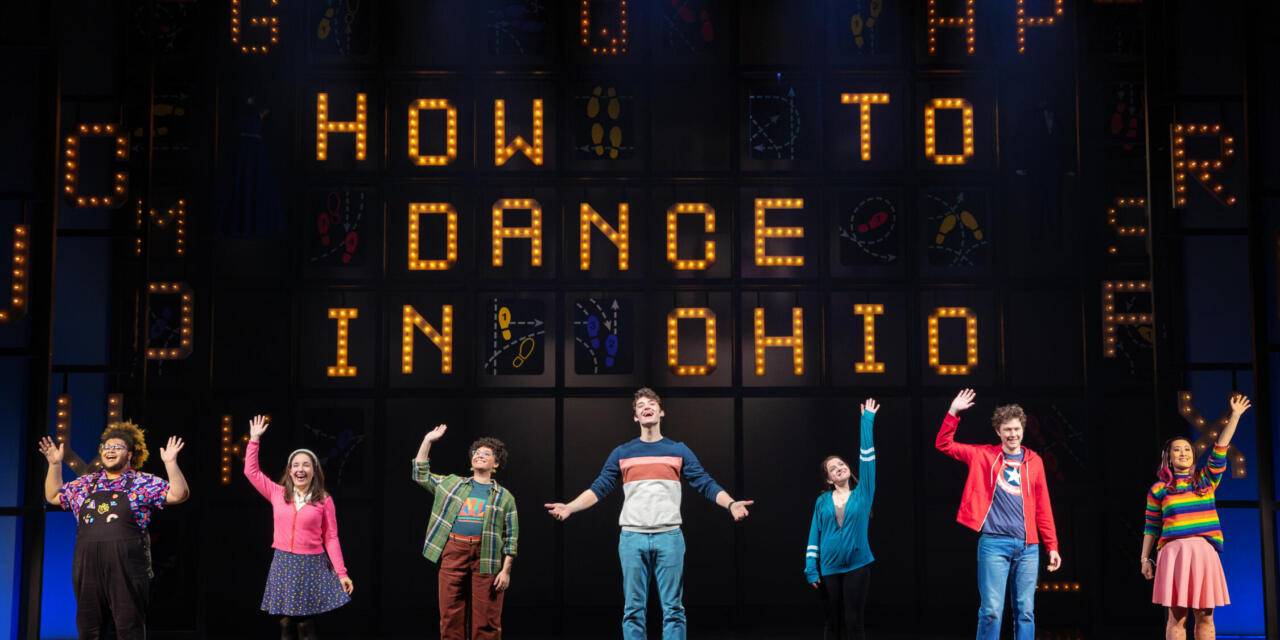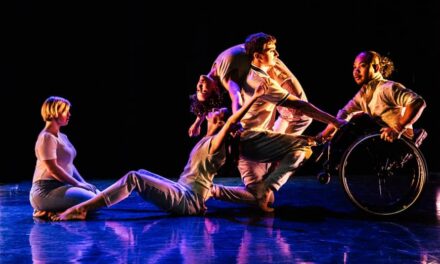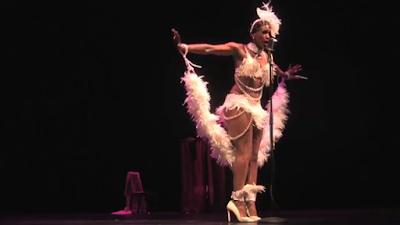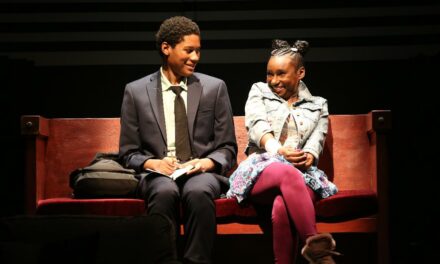On Monday How to Dance in Ohio, one of the most hyped shows of the 2023 Broadway fall season, announced it would close on February 11th, just one show short of 100 performances. Based on Alexandra Shiva’s 2015 documentary of the same name, How to Dance in Ohio follows seven autistic young adults (played by seven autistic actors) as they prepare for a formal dance organized through their therapy group at Amigo Family Counseling Center. Some may look at this anticlimactically early closure as evidence that people just don’t care for stories about disabled people. I would argue instead that the show lost its center by trying to cover so many experiences outside of its autistic characters. How to Dance in Ohio disappoints not because it proves Broadway isn’t ready for a show focused on the neurodivergent experience, but because despite incredible work from the seven authentically cast autistic actors, it never delivers on the promise that it really is that show in the first place. How to Dance in Ohio deserved better than an unceremoniously early closing, but disabled artists and audiences deserve better than How to Dance in Ohio.
How to Shine in Ohio

The cast of How to Dance in Ohio PC: Curtis Brown
It’s hard to understate just how incredible these seven actors (who are all making their Broadway debuts!) really are. Each plays their character with specific, lived-in honesty and the vocals are fantastic across the board. Imani Russell exudes steady cool as Mel, Connor Tague is hilarious as Tommy, and I wanted to see more of Desmond Luis Edwards as cosplayer Remy, especially showing off their cosplaying looks! One of the central love stories is arguably the friendship between vivaciously fantasy loving Jessica (Ashley Wool) and Caroline (Amelia Fei), a romantic on a journey towards claiming her own agency. The other is between Madison Kopec as Marideth and Liam Pearce as Drew who, I would argue, both deserve Tony consideration for their soaring vocals, heartfelt arcs, and chemistry.
All seven have been with the project since it premiered at Syracuse Stage in 2022 and the care they have for their characters, each other, and this story is so palpable it made me love the show even when I was at my most frustrated. As a neurodivergent theater lover/maker myself, perhaps I’m biased, but I really want to underscore that the casting of seven autistic actors is not just a historic achievement, but the casting of these specific seven actors is also an artistic triumph.
It’s also very clear that many people beyond these seven were invested in making this a radically disability forward piece. Amongst other accessibility measures, the show is sensory-friendly with cool down areas and fidgets available to borrow. There’s a sensory advisory guide, and an introduction of characters at the top of the show. This care is thanks in large part to the Access team made up of Jeremy Wein (Associate Producer), Becky Leifman (Director of Community Engagement), Ava Xiao-Lin Rigelhaupt (Autistic Creative Consultant), Nicole D’Angelo (Assistant Music Director/Script Consultant), and Liz Weber (Production Assistant). The piece and the media around it regularly provides resources and signposts how to talk about autism (and how people get it wrong). Sometimes this didacticism is a bit on the nose, but I overall appreciate the intention.
How to Falter in Ohio
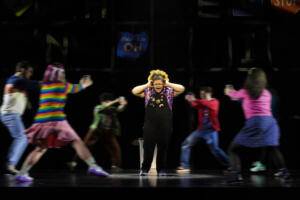
Desmond Luis Edwards and cast PC: Curtis Brown
Despite all this, it is also unfortunately very clear that director Sammi Cannold, book and lyrics writer Rebekah Greer Melocik, and composer Jacob Yandura are not themselves autistic. The show’s central conflict revolves around an ableist blogpost in which Dr. Amigo is described as a “hero” for organizing a dance for his “special needs” patients who “suffer from Autism Spectrum Disorder, which for them, and also for their families, is a life sentence.” Remy responds with the song “Nothing at All” singing, “It’s not like I’m shocked by the ableist clichés / But they do make me tired / Do I only exist on this planet to make somebody else feel inspired?” This is such an important idea to communicate, and yet much of the show still feels like it’s designed to be… well… inspiring.
The songs are broadly pretty with overly cutesy rhyme schemes. This is problematic not only because it makes all the music blend forgettably together with few stand out songs, not only because it sounds like a hundred other DearEvanBeMoreTheProms out there, but also because it limits the emotional range we get to see from these characters. At one point Mel’s boss chides them for their communication style and, not able to speak, they respond through a text to voice app. It’s a powerful moment because we get to see (rather than be told) both the ways the workplace is not structurally or socially designed for neurodivergent people, but also the sorts of accommodations and tools they can use to navigate that world. Other than this moment we rarely get to effectively see these characters experience dysregulation or overstimulation.
To its credit, this means the show doesn’t fall into trauma porn as so much disability media often does, but I still found myself desiring a fuller range of musical expression. Remy is upset in “Nothing at All”, eschewing the costumes they usually draw strength from to livestream as himself, but it’s more of a moodier, modern “Wig in a Box” meets a psa than something with real bite to it. Caroline worries when she can’t find the room she’s supposed to take an exam in, but quickly moves on from the issue. Tonally there’s no difference between the line “When he takes me in his arms slow dancing/ He holds me tightly, like he’ll never let me go” and later in the song when a stranger offers her a ride and she sings “most murders are nice at first”. Perhaps the tone is universally mellow in keeping with the design of the show to be sensory-friendly which rules out sudden loud noises and bright lights. Perhaps this is a worthwhile compromise, but perhaps autistic writers and directors could have come up with a more interesting solution.

Liam Pearce and cast PC: Curtis Brown
The press packet for the show also included a note that “while there are a few characters that are teenagers, many of the characters at Amigo Family Counseling Center are in their twenties.” I imagine this was done to prevent the way disabled people are often infantilized. I can’t help but think that the scenic design hasn’t really done itself any favors to avoid this issue. Robert Brill’s set of floating glowing letters looks better suited for Matilda than a show that pointedly does not take place at a school. Similarly, when a countdown clock is introduced, why does it look like it came off a basketball court?
But to me the most egregious problem the show has is that there are so many storylines and characters pulling focus from the autistic characters at its center. In fact, of the 22 songs listed in the program, 8 of them are sung by the non disabled characters– that’s 36%, over ⅓ of the music in the show. For a piece that claims to center the autistic experience, that seems awfully high. But then maybe I’m wrong, maybe that is not what this show is about. Maybe it is about the arc of Dr. Amigo (Caesar Samayoa), the therapist who is organizing the titular dance. After all, according to the program he is listed as featuring in six songs while the most features anyone in the counseling group gets is Drew who has only four. Not to mention the central conflict revolves around Dr. Amigo. It’s his mistake, his emotional conflict the show hinges on before Drew swoops in to save the day. But if that’s the case then isn’t the show doing exactly what it proclaims to be against? Using autistic people as a tool for allistic (non-autistic) people to learn something? For allistic people to be… inspired?
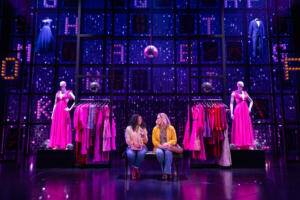
Darlesia Cearcy & Haven Burton as Jessica and Caroline’s mothers PC: Curtis Brown
Maybe the thesis of the show is neurodivergent people and neurotypical people aren’t so different after all. Jessica deals with romantic rejection, so does Dr. Amigo (in a jarring side plot). Drew deals with listening to his parents or his own intuition when considering whether or not to follow through on a dream, so does Dr. Amigo’s daughter Ashley. Everyone deals with trying things, making mistakes, failing, trying again. But again, to me what this says is that the writers don’t believe an autistic story is worth being told on its own terms for its own sake.
Ashley, while pleasantly played by Cristina Sastre, feels especially extraneous. I was promised a Broadway show historic for including autistic people. I cannot stress enough how little I care about their therapist’s daughter’s abandoned dance career. That said, according to the rule of Chekhov’s abandoned dance career, if someone is introduced as a dancer, they better eventually dance! Other than teaching some basic dance moves, Ashley never really does. She also never really takes responsibility for suddenly no longer hanging out with Mel when they were younger, blaming it entirely on the aforementioned dance career without acknowledging that actually maybe she was uncomfortable around Mel. Sometimes building community is uncomfortable and awkward and hard. Worth it! But hard!
There’s also a handful of parents who perhaps serve as welcome representation for real life parents of autistic people. To me, as with Ashley, their main effect is muddling the plot and taking time away from learning more about the autistic characters themselves.
Notably, despite the inclusion of so many incidental characters, we never see Caroline’s toxically possessive boyfriend. In general this makes sense because, again, then the focus can stay on Caroline. But Dr. Amigo gets to face off with the (comically villainous) ableist blogger. Do Melocik and Yandura think the audience can’t handle seeing Caroline in trouble? Do they think she can’t handle being in real trouble? In the context of the rest of the show, the absence just feels like its own version of sheltering and infantilization.
How to Move Forward in Ohio

Madison Kopec (center) and cast PC: Curtis Brown
Cynically, I worry all this fluff was added because the people behind the show think autistic characters are fundamentally not relatable. But the power of theater is always in its specificity. I think of the story Fiddler on the Roof book writer Joseph Stein tells about how the Japanese producer for the first non-English production asked him if Americans understood the show. “Yes, of course, we wrote it for America. Why do you ask?” He answered. And the producer replied, of the American show about poor Eastern European Jews fleeing from Russian pogroms, “Because it’s so Japanese!”
I want a version of How to Dance in Ohio that is “so Japanese”. That is to say, I want a version that is so specific, so seemingly niche, so focused and loving toward the community it depicts, people can’t help but resonate with it. As writer Jacqueline Woodson puts it, “The more specific we are, the more universal something can become.” I would like to believe this was the goal of everyone involved in the project. Perhaps this will seem in contradiction with much of what I have already said, but I wonder if what got in the way of this show was actually too much excitement about autistic representation.
I’ll explain. How to Dance in Ohio first premiered at Syracuse Stage in 2022, that’s two years ago. That is an almost unprecedentedly fast development period for a Broadway musical, most of which take five years minimum. Speaking as a disabled artist myself, I do want more disability representation and I want it urgently. But I also want disabled art to be taken seriously. It feels like everyone should have been able to see this show was not ready. There’s something magical at the heart of it, but the music, the lyrics, and the structure, are all clearly under-baked. Rushing this show to Broadway with a big campaign about the casting and representation without giving it the time, resources, support, and energy to be as strong as it could be feels like an exploitation of disability identity rather than a genuine celebration of it. Yet another way to use disabled people as inspiration without giving them the actual resources they need.
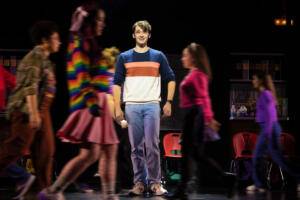
Liam Pearce and Cast PC: Curtis Brown
It’s an interesting time for disability in theater. Last year The Public had a sold-out run of Ryan J. Haddad’s Dark Disabled Stories. This year How to Dance in Ohio will close after three months. In March, actress Jenna Bainbridge will become the first wheelchair user to originate a role in a Broadway musical for her track in Suffs. That same month Tommy will open with Ali Louis Bourzgui, a non-disabled actor, playing the titular “deaf, dumb, and blind kid”.
All this to say, there’s progress, but it’s slow. And actually, it’s also to say, despite everything I’ve already said (and I’ve said a LOT), you should go see How to Dance in Ohio while you have a chance! You should see it because every member of the counseling group is so talented and makes the show really enjoyable despite its problems, you should see it to support the many disabled people who worked so hard to make this a radically accessible theater going experience, you should see it because “Waves and Wires” will give you chills. You should see this show because there are sparks of a brilliant disability art piece in it and maybe they will inspire you to make, or see, or support, the next one.
We can’t let this be the last mainstream show focused on disability because ultimately, the more disability focused shows there are, the less burden there is on this, or any one of them to contain everything– all of the non-disabled audience education around language, all the range of nuances of experience, all the experiences of family members of disabled people, their care attendants, their friends. The more disability is present, and prolific, and thriving in the theater world, the more each show can just exist on its own terms. I am excited about the boundaries How to Dance in Ohio has broken, and I’m excited for the day disabled actors on Broadway are commonplace, the day there are no more boundaries to break.
This post was written by the author in their personal capacity.The opinions expressed in this article are the author’s own and do not reflect the view of The Theatre Times, their staff or collaborators.
This post was written by Morgan Skolnik.
The views expressed here belong to the author and do not necessarily reflect our views and opinions.

